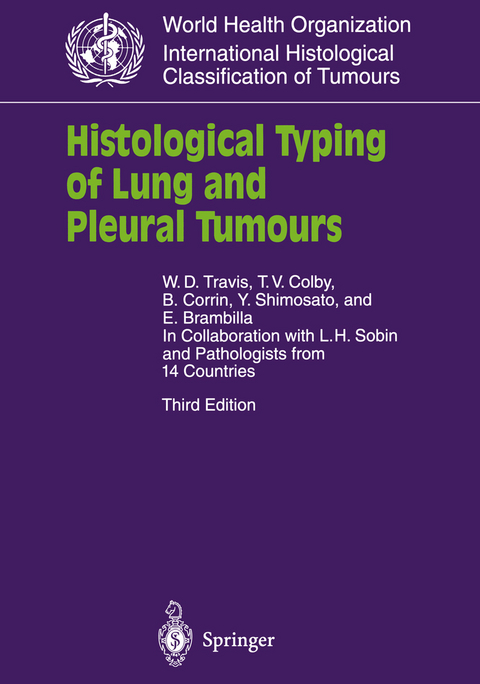
Histological Typing of Lung and Pleural Tumours
Seiten
1999
|
3rd ed.
Springer Berlin (Verlag)
978-3-540-65219-9 (ISBN)
Springer Berlin (Verlag)
978-3-540-65219-9 (ISBN)
with contributions by Pathologists from 14 Countries
Lung cancer is currently the most frequently diagnosed major cancer in the world and the most common cause of cancer mortality world wide. This is largely due to the carcinogenic effects of cigarette smoke. Over the coming decades, changes in smoking habits will greatly influ ence lung cancer incidence and mortality throughout the world. These changes may also impact upon the histological types of lung cancer. Tumour classification is important for consistency in patient treat ment, and because it provides a basis for epidemiologic and biologi cal studies. The previous WHO classification was published in 1981 and since then considerable progress has been made in our understanding of cer tain lung tumours 1. The concept of neuroendocrine tumours of the lung has been refined with recognition of large cell neuroendocrine carci noma and modification of criteria for atypical carcinoid. Atypical ade nomatous hyperplasia is now recognized as a potential precursor to adenocarcinoma. Studies have documented the histological hetero geneity of lung carcinomas, particularly among adenocarcinomas and poorly differentiated carcinomas. Molecular studies have also shown that hamartomas and sclerosing hemangiomas are true neoplasms rather than tumour-like lesions. This classification is based on histological characteristics of tumours seen in surgical or needle biopsy and autopsy material. Though a large percentage of lung carcinomas are now diagnosed on cytology specimens, the classification does not address cytology.
Lung cancer is currently the most frequently diagnosed major cancer in the world and the most common cause of cancer mortality world wide. This is largely due to the carcinogenic effects of cigarette smoke. Over the coming decades, changes in smoking habits will greatly influ ence lung cancer incidence and mortality throughout the world. These changes may also impact upon the histological types of lung cancer. Tumour classification is important for consistency in patient treat ment, and because it provides a basis for epidemiologic and biologi cal studies. The previous WHO classification was published in 1981 and since then considerable progress has been made in our understanding of cer tain lung tumours 1. The concept of neuroendocrine tumours of the lung has been refined with recognition of large cell neuroendocrine carci noma and modification of criteria for atypical carcinoid. Atypical ade nomatous hyperplasia is now recognized as a potential precursor to adenocarcinoma. Studies have documented the histological hetero geneity of lung carcinomas, particularly among adenocarcinomas and poorly differentiated carcinomas. Molecular studies have also shown that hamartomas and sclerosing hemangiomas are true neoplasms rather than tumour-like lesions. This classification is based on histological characteristics of tumours seen in surgical or needle biopsy and autopsy material. Though a large percentage of lung carcinomas are now diagnosed on cytology specimens, the classification does not address cytology.
Histological Classification of Lung and Pleural Tumours.- Definitions and Explanatory Notes.- Epithelial Tumours.- Soft Tissue Tumours.- Mesothelial Tumours.- Miscellaneous Tumours.- Lymphoproliferative Diseases.- Secondary Tumours.- Unclassified Tumours.- Tumour-Like Lesions.- TNM Classification of Lung Carcinoma.- TNM Classification of Malignant Mesothelioma of the Pleura.- Illustrations.
| Erscheint lt. Verlag | 23.4.1999 |
|---|---|
| Reihe/Serie | WHO. World Health Organization. International Histological Classification of Tumours |
| Mitarbeit |
Assistent: L.H. Sobin |
| Zusatzinfo | XIII, 156 p. 150 illus. in color. |
| Verlagsort | Berlin |
| Sprache | englisch |
| Maße | 170 x 242 mm |
| Gewicht | 430 g |
| Themenwelt | Medizinische Fachgebiete ► Innere Medizin ► Pneumologie |
| Medizin / Pharmazie ► Medizinische Fachgebiete ► Onkologie | |
| Studium ► 2. Studienabschnitt (Klinik) ► Pathologie | |
| Schlagworte | Bronchialkrebs • carcinoma • classification • Histopathologie • Lung • Lungenkrebs • mesothelioma • tissue • TNM staging system • Tumor • Tumours |
| ISBN-10 | 3-540-65219-1 / 3540652191 |
| ISBN-13 | 978-3-540-65219-9 / 9783540652199 |
| Zustand | Neuware |
| Haben Sie eine Frage zum Produkt? |
Mehr entdecken
aus dem Bereich
aus dem Bereich
Aus der Praxis für die Praxis
Buch (2022)
Thieme (Verlag)
CHF 99,40
International Trauma Life Support (ITLS)
Buch | Softcover (2024)
Hogrefe AG (Verlag)
CHF 91,00


